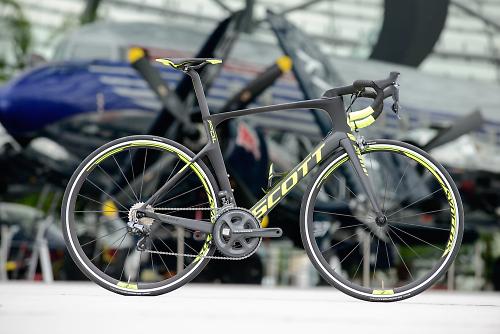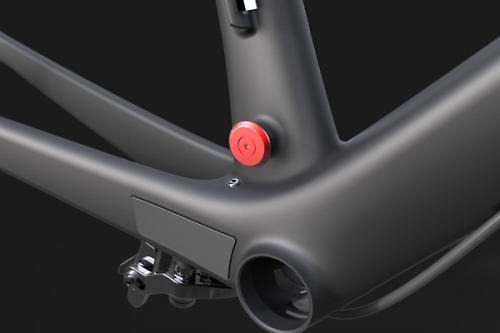- News
- Reviews
- Bikes
- Accessories
- Accessories - misc
- Computer mounts
- Bags
- Bar ends
- Bike bags & cases
- Bottle cages
- Bottles
- Cameras
- Car racks
- Child seats
- Computers
- Glasses
- GPS units
- Helmets
- Lights - front
- Lights - rear
- Lights - sets
- Locks
- Mirrors
- Mudguards
- Racks
- Pumps & CO2 inflators
- Puncture kits
- Reflectives
- Smart watches
- Stands and racks
- Trailers
- Clothing
- Components
- Bar tape & grips
- Bottom brackets
- Brake & gear cables
- Brake & STI levers
- Brake pads & spares
- Brakes
- Cassettes & freewheels
- Chains
- Chainsets & chainrings
- Derailleurs - front
- Derailleurs - rear
- Forks
- Gear levers & shifters
- Groupsets
- Handlebars & extensions
- Headsets
- Hubs
- Inner tubes
- Pedals
- Quick releases & skewers
- Saddles
- Seatposts
- Stems
- Wheels
- Tyres
- Health, fitness and nutrition
- Tools and workshop
- Miscellaneous
- Cross country mountain bikes
- Tubeless valves
- Buyers Guides
- Features
- Forum
- Recommends
- Podcast
TECH NEWS
Video: Scott's new Foil aero road bike is more aero, comfortable and stiffer
Scott has updated its Foil aero road bike, first introduced to the world back in 2010, with a newly designed frame that it claims offers a 6 watt drag reduction, is 70g lighter, 13% stiffer in the bottom bracket and is 89% more compliant than the previous bike.
“The new Foil combines excellent aerodynamic properties, high lateral stiffness, a compliant rear triangle and a frame weight that is among the lightest in the aero road bike segment,” says Scott Product Manager Frank Oberle.
Scott’s Foil was one of the first of the new generation of road bikes designed to be aerodynamic, with truncated airfoil tube shapes developed around the confines of the UCI’s 3:1 airfoil ratio rule. Following its debut, the Foil has racked up numerous victories at the highest level, including 15 Grand Tour stages and three Classics, but with the aero road bike category getting increasingly competitive this year, it was time for an update.
Scott then has spent the last 2.5 years completely reworking the frame design, with every section and tube of the frame “optimised independently and in conjunction with each other.” According to engineer Paul Remy, the vertical frame sections of the new Foil are responsible for the vast majority of the reduction in drag. That includes the fork, head tube, seat tube, seatstays and seatpost. Each has been developed independently and in conjunction with each other to reduce drag.

Scott says its research reveals that at low yaw angles up to 50% of the total drag comes from the front of the frame. For this reason, the company has redeveloped the head tube, changing the profile by adding additional layers of carbon fibre. Scott has also smoothed the transition area between the fork crown and the frame, by lowering the down tube around the rear of the fork, which narrows the gap between fork and frame and reduces drag.

An easily identifiable change from the old Foil is the new rear triangle. The seatstays are lowered and meet the seat tube much further down, which Scott says improves airflow around this area. The seat tube also hugs the curve of the rear wheel as well, closing the gap between the frame and tyre/rim. Scott has also adopted Shimano Direct Mount brakes front and rear, the rear brake positioned underneath the chainstays.

As with the previous Foil, all cables are internally routed, but the new Foil now has a single entry point on top of the down tube for all the gear and brake cables. Scott claims this single entry point is more aerodynamic than side cable entry points because the cables are hidden behind the head tube, and because there’s just one hole in the frame there’s less added weight. It’s compatible with mechanical and electronic groupsets.
The new Foil retains the same aero seatpost with integrated seat clamp as the previous model, but the seat clamp has been rejigged, with the bolt now located on the top of the top tube, rather than at the side as before. The seatpost is available with a 5 or 20mm setback.
- 12 of the fastest aero road bikes
Integration is a bigger component of the Foil’s design, with a fully integrated Syncros RR1.0 Cockpit, developed solely for the Foil, aimed at reducing the frontal surface area and drag over the front of the bike.

The new one-piece handlebar and stem features internal routing for mechanical and electronic groupsets, and the Shimano Di2 junction box is smoothed away inside the handlebar. The cables sprout out from the bottom of the handlebar and are routed into the down tube of the frame. It’s not quite as cleanly packaged as Specialized’s new Venge, which fully houses all the cables inside the handlebar, stem and frame.
The Syncros RR1.0 Cockpit weighs a claimed 395g and is available in 9 different bar width and stem length options, and with a choice of two Garmin out-front mounts.

All of the changes have resulted in reduced drag. In a test by German TOUR Magazine, the new Foil is said to save 6 watts on average, equating to 27 seconds over 40km at an average speed of 45kph, when compared to the previous Foil.
- Review: Scott Foil 15 aero road bike
As well as improved aerodynamics, Scott has addressed stiffness and comfort with the new Foil. Increasing stiffness is the new down tube, which has the same aerodynamic profile as the previous Foil, but has an increased diameter where it reaches the PF86 bottom bracket. Scott claims a 13% stiffness increase in the bottom bracket area. Another benefit of increasing the width of the down tube is that it further conceals the water bottle from the air flow, and it also means less air hits the seat tube.

Head tube stiffness has been increased by a claimed 13.5%, achieved with a new tapered 1 1/4in to 1 1/2in tapered steerer tube. The new frame uses the same diameter head tube as the previous Foil, but the removal of the aluminium insert has freed up space for the larger steerer tube. Scott also claims a 6% boost in lateral fork stiffness.
A criticism frequently levelled at the previous Foil was its harsh ride, and lack of comfort over anything but the smoothest road surface. Scott is confident it has addressed this failing, with new thin seatstays and lower seatstay mount on the seat tube, which the company claims provides an 86% increase in vertical compliance in the seat tube area. That's not all, Scott has also boosted compliance by a claimed 11% with the new fork as well.

Also helping comfort will be the 25mm tyres the Foil has been optimised for, with tyres and rims getting wider, but the Foil will apparently accept 28mm tyres. There’s a neat integrated chain guard on the seat tube, just above the bottom bracket shell.
The new Foil is lighter too by about 70g, with a claimed 945g size medium frame weight and 335g fork, providing a frameset weight of 1,280g.
Scott will offer five Foil models, with the Foil Premium decked out with Dura-Ace Di2 and Zipp 404 wheels, down to the Foil 30 with Shimano 105 and Shimano RS330 wheels. No UK prices have been announced.
More at www.scott-sports.com/global/en/
David worked on the road.cc tech team from 2012-2020. Previously he was editor of Bikemagic.com and before that staff writer at RCUK. He's a seasoned cyclist of all disciplines, from road to mountain biking, touring to cyclo-cross, he only wishes he had time to ride them all. He's mildly competitive, though he'll never admit it, and is a frequent road racer but is too lazy to do really well. He currently resides in the Cotswolds, and you can now find him over on his own YouTube channel David Arthur - Just Ride Bikes.
Latest Comments
- OnYerBike 29 min 16 sec ago
I've no idea what the situation is here, but I've seen plenty of "under construction" cycle lanes where there are only signs/barriers around the...
- Pub bike 30 min 57 sec ago
I see - Nokon avoids the problem of radial or longitudinal wires altogether using short solid segments that are non-compressible.
- the little onion 36 min 13 sec ago
whereas the whole point is that they didn't hit you this time
- Tom_77 49 min 49 sec ago
AIUI an entering-circulating accident [sic] would be when the vehicle entering the roundabout fails to give way to the vehicle circulating.
- chrisonabike 1 hour 8 min ago
Which is great - but you can only take a bus which exists eg. is going somewhere near where you want to go, when you want to go....
- mdavidford 2 hours 59 min ago
Erm, does someone need counting lessons?
- Willem1 3 hours 11 min ago
My cannondale SuperSix gen3 frameset i recently bougth has a sticker saying: made in China. Dont know about the newest models.
- SimoninSpalding 3 hours 55 min ago
Cos style, and did you not read it only weighs 158g!...
- chrisonabike 4 hours 20 min ago
It's strange - some folks who grew up there say it was a great community and has declined. Some folks say it was "like Beiruit" and has calmed down...
- hawkinspeter 4 hours 28 min ago
This looks like an appropriate article to put this link for later use:...
















Add new comment
8 comments
RIP nice stems.
It has the look of Look...
Chainstay brake
Looking at this "new, improved" frameset I have a new appreciation for how advanced the design of the original Cervelo S5 was.
Oh God I feel the divorce may be round the corner (s-1 rule) !!!
I too have no idea what "89% more compliant than the previous bike" means. Does it mean that when you want to turn right, it goes right 89% of the time more than before? I'm sure if you read up on the previous model it too was xx% more whatever than the one before that.....it's a nice colour though
Well Scott says "86% increase in vertical compliance in the seat tube area" so I'm guessing that means the improved ride comfort is coming from the fact it has managed to make the seat tube more compliant and the seat post deflect more than the previous Foil.
There was no previous bike before the original Foil for it to measure against though
I'll hopefully get a ride on the new Foil to see how its claims actually stack up. I rode the old Foil loads so it would be interesting to compare the new with the old
Awesome:
-Compliance increased by 11%
-Head tube stiffness increased by 13.5%
-6% boost in lateral fork stiffness
-13% stiffer in the bottom bracket
-A graph that shows yaw angles vs drag power, the line goes up and down again
I have no idea what any of this means, but FFS take my money.